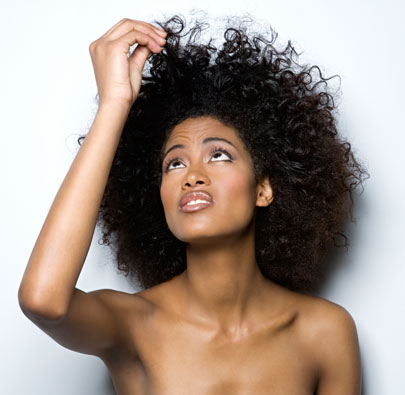Somewhere between the hurricane of hormones that floods the body and the prenatal vitamins that most expectant mothers take, something beautiful happens to our hair during pregnancy. We start to enjoy how our tresses grow like a weed and grab every opportunity to show off the volume and strength that we gain like we are models on a runway. But, soon after we welcome our sweet babies into the world, our bodies begin to ‘detox’ these hair-nourishing hormones as well. Voila! Hair today, gone tomorrow. Suddenly, we see balls of our beautiful curls coming out in our combs, brushes and in the shower. Now, if the baby blues aren’t in full swing already, be sure that the sight of bald spots will get your spirit plummeting into depression like a pelican that has spotted a red snapper in Kingston Harbour.
Postpartum alopecia (hair loss) is a harsh reality for many new mothers – especially noticeable for those who had long hair prior to being pregnant. In many cases, it is simply a matter that the hair (which sheds less during pregnancy) does a marathon shed about 3 months after childbirth. However, in some cases the emotional and physical stress that comes post-childbirth can result in hair loss, as well. Either way, some women never notice it, because they get braid extensions right before their due dates; and others do a big chop right after giving birth, so they never get to see the transformation. Well, I never missed the chance and I was horrified when I saw that bald spot in a candid photo. My waist-length locs – that get me stopped in public and led to gigs as a natural hair model – started thinning at the front of my hairline!
I was devastated! “Why didn’t anyone warn me? Would I lose any of my locs? What was I going to do for the next photoshoot? Would anyone think my locs had caused my hair loss?” The questions harangued me constantly! But, my hairloss was the result of my new post-partum lifestyle and not the hormonal shift. Always feeling exhausted, handling round-the-clock feedings and diaper changes, trying to remember to sleep, shower and eat – I just thought it would be easier to style my locs in a Mommy Bun and my hair stayed in a bun everyday, for quite a while… I really didn’t have the physical nor mental energy to style my hair, much more to moisturise, do scalp massages or hot oil treatments. It’s not like I was going anywhere aside from the supermarket or my doctor’s office – so where was the motivation to change up my daily hairstyle? But, that never stopped traction and neglect from peeling out the sides of my crowning glory.
Interestingly, most articles on postpartum hair loss will address the hormonal shift and explain that if you just wait a few months, your hair will be back to normal. But, I am yet to come across anything that addresses the hair loss that results from the mother-to-a-newborn lifestyle. Whether you just quit combing your hair or you started to tear out fistfuls in frustration – the hair is still lost! So, what’s a girl to do? Well, eventually, I pulled myself together and I knew what I had to do:
1. Rest My Scalp – with loose, hanging styles.
I sectioned off the affected areas of my hair and put my locs in large, loose plaits and secured the ends with a rubber band. This allowed me to keep my long hair out of my way and out of the reach of my baby – who thinks my locs are bungee cords! I could wear these large plaits in different styles when I had to go on the road, or let my locs hang freely during the day and put them in plaits for bedtime.
2. Nourish My Scalp – with soothing and healing natural oils and herbs.
I chose an all-natural scalp treatment made from a combination of herbal extracts and Jamaican oils (like black castor, coconut, pimento and moringa) that are good for restoring scalp health. Everyday before stepping into the shower, I’d apply a drop of the treatment to the affected areas and just let the healing begin.
3. Massage My Scalp – with my finger tips.
Scalp massage had always been a part of my grooming habits, especially because I don’t use combs or brushes (which can help to stimulate blood flow in the scalp). So, after my scalp had been traumatised, from wearing my hair in the same style for weeks, I had to show it some tender love and care. Everyday, after applying the oily treatment, I would use my fingertips to apply light circular pressure for a minute or two, to the affected areas.
I can testify that postpartum hair loss can be devastating. It can worsen the baby blues and pack a stiff uppercut to a new mother’s self-image (on top of the resident body issues). But, postpartum alopecia doesn’t have to be permanent. After a month of resting, nourishing and massaging my scalp, it was a complete turn around! No one could tell that I had had missing patches from my temples or a thinned hairline. Of course, the extent of the damage, my overall health and lifestyle – yes, I was chugging those green smoothies – had a whole lot to do with my end results. But, if you sit down with your dermatologist or trichologist, they will definitely endorse this approach for bouncing back from stress and trauma-related hair loss. So, don’t be despondent. You won’t have to shave your head, wear wigs or scarves forever. Just give you scalp some rest, nourish it, massage and repeat!
Didan Ashanta is a natural living enthusiast who blogs at DidanAshanta.com. A native of Jamaica, she currently lives in Tokyo with her husband and 9-month-old daughter.

